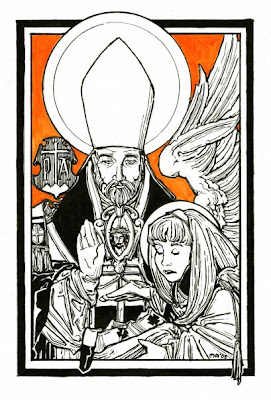Thursday, June 26
Corsica and Eden: Recent Work from Matthew Alderman
 The Authoress Dawn Eden. Commissioned for her website. Ink on vellum with marker. June 2008. Click for larger version.
The Authoress Dawn Eden. Commissioned for her website. Ink on vellum with marker. June 2008. Click for larger version.My new portrait of Dawn Eden, specially commissioned for her weblog, is now up at the Dawn Patrol. Because it was a portrait rather than a liturgical illustration, and because Dawn is one of the hippest people I know--and I mean that in the good sense--I decided to experiment a bit stylistically. I sought to give it a more "graphic," simplified feel without resorting to straight-out modernism. The art deco-cum-Beuronese Sacred Heart medallion complements this mood, principally set by the background, which has a touch of Gustav Klimt in terms of composition and Mondrian in color. Yes, when Matt wants to be modern, he references artists who died respectively in 1918 and 1944. Make of that what you will.
My first portrait of Dawn, which has since been rendered obsolete by a new hairstyle, was one of my more ambitious drawings when I first started out, and is probably the largest work I've done in ink to date; while it had some difficulties as a portrait--for one thing, it looked a bit too much like a piece of religious art--it seems to have had its own fans over at Dawn's site. I hope they'll enjoy the new one, which, while smaller and simpler than the last portrait, was a lot of fun to create and, in its own way, reflects a bit of the subject's distinct spunk.
 S. Alexander Sauli. Commissioned as a confirmation gift. Ink on vellum with marker. June 2008.
S. Alexander Sauli. Commissioned as a confirmation gift. Ink on vellum with marker. June 2008. I was recently asked to do an image of the unjustifiably-obscure Counter-Reformation bishop-saint, Alexander Sauli, known as the Apostle of Corsica. S. Alexander was a Lombard aristocrat by birth who, after joining the Clerks Regular of S. Paul, the Barnabites, became variously a professor at the University of Pavia, superior-general of his congregation, and finally bishop of the ancient see of Aleria in Corsica, where he nearly single-handedly revived the island's derelict faith. He died after being made bishop of Pavia, in 1591, and somehow, amid all this, served at some point as S. Charles Borromeo's spiritual director.
While we know what S. Alexander looked like (his face is distinctive enough in the few portraits I've seen), he has a fairly indistinct iconography, the usual episcopal tropes: bishop's habit, book, crozier, mitre, biretta, the like. The one unique emblem I was able to find was a bit inexplicable: he's shown either accepting or spurning a pallium proferred to him by a cherub in a 19th century holy-card. The gesture is equivocal--I can either assume he served as an archbishop at some point, or perhaps refused such an offer out of humility. The relatively short turn-around time on the project meant I didn't have the opportunity to dig too deep here, unfortunately. At the very least, there is still a precedent, and worse comes to worse, it's up there with St. Agatha's, er, bells.
While my first sketches simply showed a standard Tridentine bishop-saint with an angel bearing his crozier behind him, I changed it to incorporate the pallium and the bishop's somewhat ambivalent response, as it was more distinctive symbolically, and also led to a more interesting composition. A few more discrete emblems can be glimpsed in the drawing: the face of the Man of Sorrows on his large pontifical morse, a pun on his name, which means "Saviour of Mankind" in Greek and the emblem of the Barnabite order.
The profile of the mitre could have been rendered a bit more smoothly, and, as always, there are a fair number of things I'd like to change--anatomical gaffes, line-weights, missed possibilities for more symbolism--but I'm fairly pleased with the result; furthermore, this is the first time I've managed to (successfully) incorporate a large amount of another color besides red into one of my works. The possibilities are endless.












